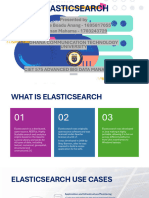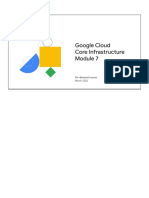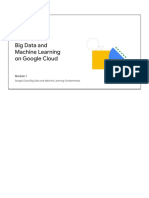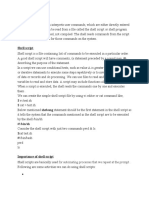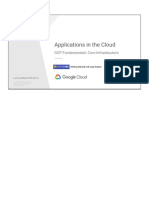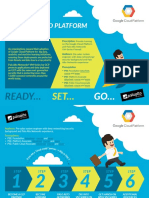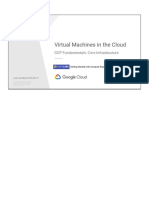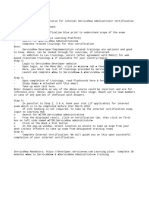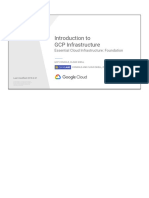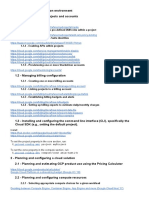0 ratings0% found this document useful (0 votes)
155 views14 pagesGCP Associate Guide
google exam guide
Uploaded by
samiransdcCopyright
© © All Rights Reserved
We take content rights seriously. If you suspect this is your content, claim it here.
Available Formats
Download as PDF or read online on Scribd
0 ratings0% found this document useful (0 votes)
155 views14 pagesGCP Associate Guide
google exam guide
Uploaded by
samiransdcCopyright
© © All Rights Reserved
We take content rights seriously. If you suspect this is your content, claim it here.
Available Formats
Download as PDF or read online on Scribd
You are on page 1/ 14
1 - Setting up a cloud solution environment
1.1 - Setting up cloud projects and accounts
4.4.4 - Creating projects
4.1.2 - Assigning users to pre-defined IAM roles within a project
41.4.3 - Linking users to G Suite identities
bitps:lisupport.google.comicloudidentitylanswwer(73192512hI=en
1.4.4 - Enabling APIs within projects
httpsilicloud, google,com/sdk/gcloud/reference/services!
1.1.5 - Provisioning one or more Stackdriver accounts
hitps//cloud. google. com/monitoringlaccaunts!
1.2 - Managing billing configuration
1.2.4 - Creating one or more billing accounts
4.2.2 - Linking projects to a billing account
4.2.3 - Establishing billing budgets and alerts
4.2.4 Setting up billing exports to estimate dailymonthly charges
1.3 - Installing and configuring the command line interface (CLI), specifically the
Cloud SDK (e.g., setting the default project).
Install
‘To set the project property in the core section, run:
Sgoiouc contig ash protect myProject.
‘To set the zone property in the compute section, run’
S.goloud config sel compute/zone asia-easti-b
2-Planning and configuring a cloud solution
2.1 - Planning and estimating GCP product use using the Pricing Calculator
2.2 - Planning and configuring compute resources
2.2.4 -Sel
ing appropriate compute choices for a given workload
2.2.4.1 -Compute Engine
‘And Compute Engine is, basically, kind of everything else, or even all of those things if you want. I's VM.
So you have full control to do whatever you need to do to connect things together.
Its also a really good fit for existing systems.
2.2.1.2 -Kubernetes Engine
Container Engine is a system of containers working together to solve your problems.
2.2.4.3 - App Engine
Getto know Google App Engine
‘App Engine is focused on making your web code run extremely well.
Its optimized for that. And i's code first kind of thinking,
2.22-- Using praamptibla VMs and custom machine types as appropriate
1. // CREATE INSTANCE WITH 4 vCPUs and 5 GB MENORY
2. gcloud compute instances create my-vm --custom-cpu 4 --custon-nenory 5
3
4. // ENABLE PREEMPTIBLE OPTION
5. gcloud compute instances create my-vm --zone us-central1-b --preenptible
2.3 - Planning and configuring data storage options
Etom_blobs to relational tables: Where do | store my Data? (Google Cloud Next'17)
Siar @ oom e
SS aS Giz
—— ——
Qos © cue @ at. @ inns || @ rin
2.3.1 - Product choice
2.3.4.4 -Cloud SQL
Cloud SQL is a fully-managed database service that makes it easy to set up, maintain, manage, and administer
your relational databases on Google Cloud Platform
2.3.1.2 -BigQuery
A fast, highly scalable, cost-effective and fully-managed enterprise data warehouse for analytics at any scale
BigQuery is Google's serverless, highly scalable, low cost enterprise data warehouse designed to make all your
data analysts productive. Because there is no infrastructure to manage, you can fecus on analyzing data to
find meaningful insights using familiar SQL and you don't need a database administrator. BigQuery enables you
to analyze all your data by creating a logical data warehouse over managed, columnar storage as well as data
from object storage, and spreadsheets. BigQuery makes it easy to securelyshare insights within your
organization and beyond as datasets, queries, spreadsheets and reports. BigQuery allows organizations
tocapture and analyze dat
in real-time using its powerful streaming ingestion capabiliy so that your insights
ways current. BigQuery is free for up to 1TB of data analyzed each month and 10GB of data stored.
2.3.4.3 - Cloud Spanner
bitps.J4cloud.google.com/spannert
‘The first horizontally scalable, strongly consistent, relational database service
Cloud Spanner: The best of the relational and non-relational worlds
cxoun anne RADITIONAL RELATIONAL TRADITIONAL NON RELATIONAL
sear v Yes v x No
v Yes ve x Ne
° Y Sion YY S103 x
praia v Hoh X Faloner v tah
sal Y Hewizntal X Veta Y Hosectl
rept VY hutomate © covtguadie (centric
2.3.1.4 - Cloud Bigtable
bips.Jlcloud.gaogle.cam/bigtabley
2.3.2 - Choosing storage options
bins cloud google com/storage/docs/gsutilcommandsimb
2.3.21 -Regional
Storing frequently accessed in the same region as your Google Cloud DataProc or Google Compute Engine
instances that use it, such as for data analytics.
2.3.2.2 - Multi-regional
Storing data that is frequently accessed (‘hot” objects) around the world, such as serving website content,
streaming videos, or gaming and mobile applications.
2.3.2.3 = Nearline
Data you do not expect to access frequently (e., ne more than once per month). Ideal for back-up and serving
Jong-il multimedia content.
2.3.2.4 -Coldline
Data you expect to access infrequently (e., no more than once per year). Typically this is for disaster recovery, or
data that is archived and may or may not be needed at some future time,
Price (per
StorageClass | Characteristics Use Cases GB per
month)"
Multi:Regional | © >99.99% typical monthly _| Storing data that is frequently $0.026
Storage availability accessed (‘hot” objects) around the
‘+ 99.95% availabilty SLA” | world, such as serving website
© Geo-redundant content, streaming videos, or gaming
and mobile applications.
Regional ‘+ 99.99% typical monthly Storing frequently accessed inthe | $0.02
Storage availabilty same region as your Google Cloud
‘* 99.9% availability SLA* DataProc or Google Compute
‘+ Lower cost per GB stored | Engine instances that use it, such as
‘* Data stored in a narrow {or data analytics.
geographic region
* Redundant across
availabilty zones
Neartine '* 99.9% typical monthly Data you do not expect to access | $0.01
Storage availabilty frequently (e., no more than once
‘+ 99.0% availability SLAY per month). Ideal for back-up and
‘© Very low cost per GB stored | serving long-tail multimedia content,
© Data retrieval costs
'* Higher per-operation costs
© 30-day minimum storage
duration
Goldline ‘© 99.9% typical monthly Data you expect to access $0,007
Storage availability infrequently (ie., no more than once
+ 99.0% availability SLA* Per year). Typically his is for disaster
‘+ Lowest cost per GB stored | recovery, or data that is archived and
© Data retrieval costs may or may not be needed at some
‘* Higher per-operation costs | future time.
‘© 90-day minimum storage
duration
2.4 - Planning and configuring network resources
2.4.4 - Different
jing load balancing options
httpsilicloud. google,com/compute/docsiload-balancinglinternall
2.4.2 - Identifying resource locations in a network for availability
2.4.3 - Configuring Cloud ONS
btips:licloud.google.comidasiquickstart
3 - Deploying and implementing a cloud solution
3.1 - Deploying and implementing Compute Engine resources
3.4.4 - Launching a compute instance using Cloud Console and Cloud SDK (gcloud)
3.4.4.1 assign disks
[--disk=[auto-delete=AUTO-DELETE | , [boot-B007}, [device-name-DEVICE-NAME] , [mode-MODE], |
name-NAME} ]
3.4.4.2 -availabllty policy
3.4.4.3 + SSH keys.
3.4.2 - Creating an autoscaled managed instance group using an instance template
‘You can create two types of managed instance groups:
‘© A zonal managed instance group, which contains instances from the same zone.
‘* Aregional managed instance group, which contains instances from multiple zones across the same region.
3.1.3 - Generating/uploading a custom SSH key for instances
3.1.4 - Configuring a VM for Stackdriver monitoring and logging
3.1.5 - Assessing compute quotas and requesting increases
hitpsiliconsole.cloud. google,comliam-adminiquotas2proje
hitpsilicloud. gaogle,com/monitoringiquotas
le i quotas:
3.1.6 - Installing the Stackdriver Agent for monitoring and logging
hitnsJ/cloud, google, com/menitoring/agentinstall-agent
3.2 - Deploying and implementing Kubernetes Engine resources
‘ubemetes Design and Architecture
3.2.4 - Deploying a Kubernetes Engine cluster
btpscloud google com/kubamatas-engine/docs/cancapis/clister-architectura
3.2.2 - Deploying a container application to Kubernetes Engine using pods
geloud config set container/cluster [CLUSTER_NAME]
gcloud container clusters get-credentials [CLUSTER NAME]
3.2.3 - Configuring Kubernetes Engine application monitoring and logging
biips.kubernetes io/dacs/tasks/debug-application-clusterilagging-stackdriver!
geloud beta container clusters update
ust
system -o yaml > éluenti
jep-v2.0
prds. yal
-yaml
3.3 - Deploying and implementing App Engine and Cloud Functions resources
3.3.1 - Deploying an application to App Engine
Instance Instance Instance Instance
3.3.1.1 -sealing configuration
hitps//cloud. google. com/appengine/docs/standardipython/how-instances-are-managed
The scaling type you assign to a service determines the whether its instances are resident or dynamic:
‘© Auto scaling services use dynamic instances.
‘* Manual scaling services use resident instances
‘* Basic scaling services use dynamic instances.
Manual scaling
Aservice with manual scaling use resident instances that continuously run the specified number of instances
irrespective ofthe load level, This allows tasks such as comple iniaizations and applications that rely on the state
‘of the memory over time.
‘Automatic scaling
‘Auto scaling services use dynamic instances that get created based on request rate, response latencies, and other
application metrics. However, if you specify @ number of minimum idle instances, that specified number of
instances run as resident instances while any additional instances are dynamic.
Basic Scaling
Aservice with basic scaling use dynamic instances. Each instance is created when the application receives a
request. The instance will be turned down when the app becomes idle. Basic scaling is ideal for work that is
intermittent or driven by user activity
3.3.1.2 -versions
The recommended approach is to remove the version element from your app.yam file and instead, use a
command-line flag to specify your version ID:
hhps:lcloud google. comlappengina/dacs/admin-apildeplayina-apps
gcloud app deploy ~v [YOUR_VERSTON_rD)
appcfg.oy update -V [YOUR VERSTON_ TD)
3.3.1.3 -traffic splitting
3.3.2 - Deploying a Cloud Function that receives Google Cloud events
3.3.2.1 - Cloud Pub/Sub events
3.3.2.2 - Cloud Storage object change notification events
htnsilicloud.goagle.com/functionsidocs/calling/storage
3.4 - Deploying and implementing data solutions
3.4.4 «Inti
ing data systems with products
3.4.1.4 -Cloud SL
3.4.1.2 -Cloud Datastore
3.4.1.3 -Cloud Bigtable
3.4.1.4 -BigQuery
3.4.15 -Cloud Spanner
3.4.1.6 - Cloud Pub/Sub
3.4.1.7 -Cloud Dataproc
3.4.1.8 -Gloud Storage
3.4.2- Leading data
3.4.21 - Command ine upload
3.4.22 -API transfer
3.4.2.3 - Import / export “
hitpsilictoud.gaagle.comisalidacsimysalimpor-expartt
hhpsulloud google. com/salldocs/nostoreslimpor-expod
3.42.5 - streaming data to Cloud PubiSub
btlpsulicioud.gogle.com/pubsub/dacs/quickstar-ci
3.5 - Deploying and implementing networking resources
3.5.1 - Creating a VPC with subnets
3.5.4.1 -Custom-mode VPC
3.5.4.2 «Shared VPC
3.5.2- Launching a Compute Engine instance with custom network configuration
3.5.2.1 -Internal-only IP address
[--enable-private-ip-g ss]
Enableidisable access to Google Cloud APIS from this subnet for instances without a public ip address.
3.5.2.2 - Google private access
hiipsu/cloud.google.com/sdk/gcloudireference/camputelinstancesicreate
[--private-network~ip=PRIVATE NETWORK_IP’
3.5.2.3 - Static external and private IP address
ess-ADDRESS =-no-ad
3.5.2.4 - network tags
[--tage-2AG, (TAG, |]
43.5.3 - Creating ingress and egress firewall rules for a VPC
[--direction=DIRECTION}
If direction is NOT specified, then defaultis to apply on incoming trafic. For incoming trafic, itis NOT supported to
specify destination-ranges; For outbound traff, itis NOT supported to specify source-ranges or source-tags.
For convenience, 'IN' can be used to represent ingress direction and ‘OUT" can be used to represent egress
direction.
DIRECTION must be one of: INGRESS, EGRESS, IN, OUT.
3.6.3.1 -IP subnets
a -5-CIDR_RANGE, [CIDR_RANGE,
A\list of IP address blocks that are allowed to make inbound connections that match the firewall rule to the
instances on the network. The IP address blocks must be specified in CIDR format:
btipven.wikipedia.orgiwikiGlassless_Inter-Domain_Routing,
If neither ~source-ranges nor -source-tags are specified, -source-ranges defaults to 0.0.0,0/0, which means that
the rule applies to all incoming connections from inside or outside the network. If both ~source-ranges and
—source-tags are specified, the rule matches if either the range of the source matches ~source-ranges or the tag of
the source matches ~source-tags.
If neither ~source-ranges nor ~-source-tags is provided, then this flag will default to 0.0.0.0/0, allowing all sources.
“Multiple IP address blocks can be specified if they are separated by commas.
[--destination-ranges=CIDR_RANGE, [CIDR_RANGE, ..]]
‘The firewall rule wil apply to traffic that has destination IP address in these IP address block list. The IP address
blocks must be specified in CIDR formatihito:/en. wikipedia orgiwiki/Classless_Inter-Damain_Routing.
I —destination-ranges is NOT provided, then this flag will default to 0.0.0.0/0, allowing all destinations. Multiple IP
address blocks can be specified if they are separated by commas,
3.5.3.2 -Tags
rAG, (TAG,
A\listof instance tags indicating the set of instances on the network to which the rule applies if all other fields
match. If neither -source-ranges nor --source-tags are specified, -source-ranges defaults to 0.0.0.0/0, which
‘means that the rule applies to all incoming connections from inside or outside the network.
If both —source-ranges and ~-source-tags are specified, an inbound connection is allowed if either the range of the
source matches ~source-ranges or the tag of the source matches ~source-tags.
‘Tags can be assigned to instances during instance creation,
If source tags are specified then neither a source nor target service account can also be specified.
[ot FAG, (TAG,
Allist of instance tags indicating the set of instances on the network which may accept inbound connections that
match the firewall rule If both target tags and target service account are omitted, al instances on the network can
receive inbound connections that match the rule.
‘Tags can be assigned to instances during instance creation,
If target tags are specified then neither a source nor target service account can also be specified.
3.5.3.3 - Service accounts
[--s01 vice-account s=EMAIL, [EMAIL,
‘The email of a service account indicating the set of instances on the network which match a trafic source in the
firewall rule.
Ifa source service account is specified then neither source tags nor target tags can also be specified
[--tara: cunt s-EMAIL, (EMAIL,
‘The email ofa service account indicating the set of instances to which firewall rules apply. If both target tags and
target service account are omitted, the frewall rule is applied to all instances on the network,
Ifa target service account is specified then neither source tag nor target tags can also be specified
3.5.4 - Creating a VPN between a Google VPC and an external network using Cloud VPN
This diagram shows a simple VPN connection between your Cloud VPN gateway and your on-premises VPN
gateway.
Internet
On-premises
Gateway Network
VPN diagram (click to enlarge)
3.5.5 - Creating a load balancer to distribute application network traffic to an application
3.5.5-1 - Global HTTP(S) load balancer
3.5.5.2 - Global SSL Proxy load balancer
hips //cloud. google. com/compute/dacs/ioad-balancing/tcp-ssl/
3.5.5.3 - Global TCP Proxy load balancer
3.5.5.4 - Regional Network load balancer
5.8.8.8 Regional Internal led balancer
3.6 - Deploying a Solution using Cloud Launcher
hipsJ/console.cloud google. com/launcher
3.6.2 - Deploying a Cloud Launcher marketplace solution,
hitpsJ/console cloud google comauncher,
3.7 - Deploying an Application using Deployment Manager
3.7.4 - Developing Deployment Manager templates to automate deployment of an application
bitps:iiithub.com/GaogleCloudP latform/deplaymentmanager-samples
3.7.2 - Launching a Deployment Manager template to provision GCP resources and configure an
application automatically
4-Ensuring successful operation of a cloud solution
4.1 - Managing Compute Engine resources
4.4.4 - Managing a single VM instance
4444 «start
hhtis:lcloud google. com/sdk/gcloud/reference/computelinstances/statt
4.1.4.2 -stop
4.1.1.3 - edit configuration
4.1.4.4 -delete an instance
4.4.2 - SSHIRDP to the instance
4.1.3 - Attaching a GPU to a new instance and installing CUDA libraries
You can attach GPUs only to instances with a predefined machine Iype or custom machine Iyoe that you are able
to create in a zone. GPUs are not supported on sharad-core machine tynes or memory-onlimized machine typos,
htps//cloud. google. com/compute/docs/gpusladd-gpus
‘* [ACCELERATOR_COUNT] is the number of GPUs that you want to add to your instance. See GPUs on
Compute Enaine fora list of GPU limits based on the machine type of your instance.
‘* [ACCELERATOR_TYPE] is the GPU model that you want to use, See GPUs on Compute Engine for a list
of available GPU models.
4.4.4 - Viewing current running VM Inventory
4.4.4.4 -instance IDs
4.4.4.2 -details
4.4.5 - Working with snapshots
4.4.5.1 -create a snapshot from a VI
bipsi/cloud.google, com/compute/docs/disksicreate-snapshots
btinsJ/cloud google. comisdk/gcloudireference/computeldisks/create
SOURCE_SNAPSHOT
A source snapshot used to create the disks, Its safe to delete a snapshot after a disk has been croated from the
‘snapshot. In such cases, the disks will no longer reference the deleted snapshot. To get a list of snapshots in your
‘current project, run gcloud compute snapshats lst. A snapshot from an existing disk can be created using the
‘gcloud compute disks snapshot command, This flag is mutually exclusive with ~image,
‘When using this option, the size of the disks must be at least as large as the snapshot size, Use —size to adjust the
size of the disks.
4.4.5.2 - view snapshots
4.1.5.3 - delet
‘a snapshot
4.4.6 - Working with Images
4.4.6.1 - create an image from a VM or a snapshot
psa onece comedgrouselerancalcomouteimagesseaia
4.4.6.3 - delete an image
4.1.7 - Working with Instance Groups
4.1.7.1 -set auto scaling parameters
hitpsilicloud. gaogle,com/compute/doos/autoscaler!
Managed instance groups and autoscaling
Managed instance groups support autoscaling so you can dynamically add or remove instances from a managed
instance group in response to increases or decreases in load, You enable autoscaling and choose an autoscaling
policy to determine how you want to scale. Applicable autoscaling policies include scaling based on CPU utilization,
load balancing capacity, Stackdriver monitoring metrics, or by a queue-based workload like Google Cloud Pub/Sub.
Because autoscaling requires adding and removing instances from a group, you can only use autoscaling with,
managed instance groups so the autoscaler can maintain identical instances, Autoscaling does not work on
unmanaged instance groups, which can contain heterogeneous instances.
For more information, read Autoscaling Groups of Insiances.
4A72 +
ign instance template
4.1.7.3 - create an instance template
4.4.7.4 - remove instance group
bilnsJ/cloud.google.com/sdk/gcloudireference/computelinstance-groupsimanagedidelete
‘Working with management interfaces
4.1.8.1 -Cloud Console
4.1.82 -Cloud Shell
4.4.8.3 -GCloud SDK
4.2 - Managing Kubernetes Engine resources
4.2.4 - Viewing current running cluster inventory
4.2.4.4 -nodes
kubect! get nodes
4.2.4.2 -pods
kubect
4.2.1.3 - services
kabect services
4.2.2 - Browsing the container image repository and vi
4.2.3 - Working with nodes
4.2.3.1 -add anode
dips //cloud.googla.com/sak/acloudireference/containericlustarsirasiza
geloud container clusters resize [CLUSTER NAME] \
node-pool [NODE_POOL] \
=-size [SIZE]
42.3.2 -edita node
4.2.3.3 -remove a node
4.2.4 - Working with pods
42.4.1 -add pods
42.4.2 -edit pods
4.2.4.3 -remove pods
4.25 - Working with services
42.5.4 -add a service
42.5.2 -edit a service
4.2.5.3 -remove a service
4.2.6 - Wor
19 with management interfaces
4.26.1 -Cloud Console
4.2.6.2 - Cloud Shell
4.2663 -Cloud SDK
4,3 - Managing App Engine resources
4.3.1 - Adjusting application traffic splitting parameters
4.3.2 - Setting scaling parameters for autoscaling instances
4.3.3 - Working with management interfaces
4.3.3.4 -Cloud Console
43.3.2 - Cloud Shell
43.3.3 -Cloud SDK
4.4 - Managing data solutions
4.4.1 - Executing queries to retrieve data from data instances
4.4.4.4 -Cloud SQL
4.4.4.2 -BigQuery
4.4.1.3 - Cloud Spanner
4.4.1.4 - Cloud Datastore
4.4.1.5 - Cloud Bigtable
4.4.1.8 - Cloud Dataproc
4.4.2 - Estimating costs of a BigQuery query
4.43 - Backing up and restoring data instances
4.4.3.1 -Cloud SQL
44.3.2 - Cloud Datastore
4.4.3.3 - Cloud Dataproe
4.4.4 - Reviewing job status in Cloud Dataproc or BigQuery
4.4.5 - Moving objects between Cloud Storage buckets
4.4.6 - Converting Cloud Storage buckets between storage classes
4.4.7 - Setting object lifecycle management policies for Cloud Storage buckets
4.4.8 - Wor
9 with management interfaces
4.4.8.1 - Cloud Console
4.4.82 -Cloud Shell
4.4.83 - Cloud SDK
4.5 - Managing networking resources
4.5.1 - Adding a subnet to an existing VPC
hitpslcloud. google comivecidocslusing-vnc
‘Adding a new subnet to an existing VPC network
‘You can add a subnet to a region of an existing VPC network. The primary IP range of this new subnet cannot
‘overlap the IP range of existing subnets in the current network, in peered VPC networks, or in on-premises
networks connected via VPN or Interconnect.
‘You can optionally assign a secondary IP range to the subnet for use with Alias IP. The secondary IP range also
cannot overlap the IP ranges of existing connected subnets.
CONSOLE GCLOUD
geloud conpute networks subnets create [SUBNET NAME] \
network [NETWORK] \
“range [1?_RANGE] \
vondary-range [RANGE_NAME]=(2ND_
RANGE,
where
[SUBNET_NAME] is the name of the new subnet you are creating
[NETWORK] is the name of the existing network where you are creating the new subnet.
[IP_RANGE] is the primary IP range of the subnet. Example: 192.168.0.0/20.
[2ND_RANGE_NAME] is the name of the secondary IP range you can optionally create.
[2ND_IP_RANGE] is the range of the secondary IP range you can optionally create, Example: 172.16.0.0/16.
4.5.2 - Expanding a CIDR block subnet to have more IP addresses
Expanding a subnet
‘You can expand the IP range of a subnet, You cannot shrink it.
Restrictions:
‘* The new subnet must not overlap with other subnets in the same VPC network in any region.
‘* The new subnet must stay inside the RFC 1918 address spaces.
‘¢ The new network range must be larger than the original, which means the prefix length value must be a
smaller number,
‘2 Auto mode subnets start with a /20 IP range. They can be expanded to a /16, but no larger.
pute networks subnets expan
ge [SUBNRT_NAMB}
region [REGION] \
prefix-lengtn [PREFIX_LENG
[SUBNET_NAME] - the name of the subnet whose IP range you want to expand. You do not have to specify the
network because the subnet and region together identity the network
[REGION] -the region the subnet exis in.
[PREFIX_LENGTH] the new numeric prefx length forthe subnet. Must be smaller than the existing prefix length
For examplo, ifthe current subnet isa /24, the new profix length must be 23 or smaller. This might change tho fst
IP in the range. For example, if the original IP range was 10.128.131.0/24, specifying ~prefix-length 20 sets the
new IP range to 0.128.128.0120
4.5.3 -Reserving static external or internal IP addresses
4.5.3.1 -Reserving static external IP addresses
4.5.3.2 - Reserving static internal IP addresses
hittpsilicloud. google,com/compute/docsiip-addresses/reserve-statc-intemal-ip-address
4.5.4 - Working with management interfaces
4.5.4.1 -Cloud Console
4.5.42 -Cloud Shell
4.5.43 -Cloud SDK
4.6 - Monitoring and logs
ig
4.6.1 - Creating Stackdriver alerts based on resource metrics
hitps:licloud.google.com/monitoring/custom-metrics/creating-metrics
Choosing a monitored resource type
Each of your metric's data points must include a monitored resource object. Points fram different monitored
resource objects are held in different time series.
‘You can use only the following monitored resource types in your custom metrics:
‘* goe_instance Google Compute Engine instance.
‘gke_container Google Kubernetes Engine container.
dataflow_job Dataflow job.
aws_ec2_instance Amazon EC2 instance,
global Anything else.
‘Acommon practice is to use the monitored resource abject that represents the physical resource where your
application code is running. This has several advantages:
‘* You get better performance.
'* You avoid out-of-order data caused by multiple instances writing to the same time series.
‘+ Your custom metric data can be grouped with other metric data from the same instance.
If none of the instance-related resource types are appropriate, use global. For example, Google App Engine users
should use global because the resource type gae_app is not permitted in custom metric.
4.6.2 - Creating Stackdriver custom metrics
hitpsilicloud. google.com/monitoring/custom-metrics!
hittps:licloud. google.comimonitoringlapiivS/metrics-details
4.6.3 - Configuring log sinks to export logs to external systems
4.6.3.1 -on premises
4.6.3.2 - BigQuery
4.6.4 - Viewing and filtering logs in Stackdriver
4.6.5 - Viewing specific log message details in Stackdriver
4.8.6 - Using cloud diagnostics to research an application issue
4.6.6.1 - viewing Cloud Trace data
4.6.6.2 - using Cloud Debug to view an application point-in-time
4.6.7 - Viewing Google Cloud Platform status
4.6.8 - Working with management interfaces
4.6.8.4 -Cloud Console
4.8.2 - Cloud Shell
4.8.3 - Cloud SDK
5 - Configuring access and security
5.1 - Managing Iden
and Access Management (IAM)
5.1.4 - Viewing account IAM assignments
5.2 - Managing service accounts
5.2.1 - Managing service accounts with limited scopes
Best practices
In general, Google recommends that each instance that needs to call a Google API should run as a service
account with the minimum permissions necessary for that instance to do its job. In practice, this means you should
configure service accounts for your instances with the following process:
1. Create a new service account rather than using the Compute Engine default service account.
2, Grant JAM roles to that service account for only the resources that it needs,
3. Configure the instance to run as that service account
4. Grant the instance the netps: //www..qoogleapis .con/auth/cloud-platform scope.
‘Avoid granting more access than necessary and regularly check your service account permissions to make sure
they are up-to-date.
5.2.2 - Assigning a servi
account to VM instances.
'5.2.3 - Granting access to a service account in another project,
5.3 - Viewing audit logs for project and managed service
Cloud Audit Logging retums two types of logs:
‘Admin activity logs: Contains lag entries for operations that modify the configuration or metadata of a Compute
Engine resource. Any API call that modifies a resource such as creation, deletion, updating, or modifying a
resource using a custom verb fall nto this category.
Data access logs: Contains log entries for operations that perform read-only operations do not modify any data,
such as get, lst, and aggregated list methods, Unlike ausit logs for other services, Compute Engine only has
‘ADMIN_READ data access logs and do not generally offer DATA_READ and DATA_WRITE logs, This is because
DATA_READ and DATA WRITE logs are only used for services that store and manage user data such as Google
Cloud Storage, Google Gloud Spanner, and Google Cloud SQL, which does not apply to Compute Engine. There is
‘one exception to this rule: the instance.getSerialPortOutput does generate a DATA_READ log because the
method roads data directly from the VM instance.
You might also like
- Developing, Deploying, and Monitoring in The CloudNo ratings yetDeveloping, Deploying, and Monitoring in The Cloud19 pages
- Introduction To Cloud Computing: Pertemuan IiiNo ratings yetIntroduction To Cloud Computing: Pertemuan Iii94 pages
- Google Cloud Fund M8 Big Data and Machine Learning in The CloudNo ratings yetGoogle Cloud Fund M8 Big Data and Machine Learning in The Cloud44 pages
- Google Cloud Engineer Certification GuideNo ratings yetGoogle Cloud Engineer Certification Guide1 page
- CLOUD COMPUTING, Final Project, Group 2 (Aafiya, Kiran, Sumaiyya)No ratings yetCLOUD COMPUTING, Final Project, Group 2 (Aafiya, Kiran, Sumaiyya)7 pages
- Cloud Computing for Engineering StudentsNo ratings yetCloud Computing for Engineering Students42 pages
- GCP Fundamentals: Core Infrastructure: Getting Started With Google Cloud PlatformNo ratings yetGCP Fundamentals: Core Infrastructure: Getting Started With Google Cloud Platform48 pages
- Google Cloud Fund M6 Applications in The CloudNo ratings yetGoogle Cloud Fund M6 Applications in The Cloud29 pages
- T-GCPBDML-B - M1 - Big Data and Machine Learning On Google Cloud - ILT SlidesNo ratings yetT-GCPBDML-B - M1 - Big Data and Machine Learning On Google Cloud - ILT Slides63 pages
- Google Cloud DevOps Engineer Cheat SheetNo ratings yetGoogle Cloud DevOps Engineer Cheat Sheet36 pages
- GCP Fund Module 6 Applications in The CloudNo ratings yetGCP Fund Module 6 Applications in The Cloud26 pages
- Reading Preparing For ACE Module 2 v2.0No ratings yetReading Preparing For ACE Module 2 v2.030 pages
- Innovating High Availability With Cluster Shared VolumesNo ratings yetInnovating High Availability With Cluster Shared Volumes44 pages
- Prep4Sure: Real Exam & Prep4Sureexam Is For Well Preparation of It ExamNo ratings yetPrep4Sure: Real Exam & Prep4Sureexam Is For Well Preparation of It Exam7 pages
- Google Cloud Platform: Quick Overview: Build, Test and Deploy Applications On Google's InfrastructureNo ratings yetGoogle Cloud Platform: Quick Overview: Build, Test and Deploy Applications On Google's Infrastructure22 pages
- Google Cloud Platform Learning Guide PDFNo ratings yetGoogle Cloud Platform Learning Guide PDF10 pages
- Cloud Elevate Exam Process Document: Google Certified Associate Cloud EngineerNo ratings yetCloud Elevate Exam Process Document: Google Certified Associate Cloud Engineer19 pages
- Associate Cloud Engineer Exam - Free Actual Q&As, Page 5 - ExamTopicsNo ratings yetAssociate Cloud Engineer Exam - Free Actual Q&As, Page 5 - ExamTopics3 pages
- GCP Fund Module 3 Virtual Machines in The Cloud PDFNo ratings yetGCP Fund Module 3 Virtual Machines in The Cloud PDF25 pages
- GCP Fund Module 5 Containers in The CloudNo ratings yetGCP Fund Module 5 Containers in The Cloud62 pages
- Course Presentation GoogleCloudDigitalLeaderNo ratings yetCourse Presentation GoogleCloudDigitalLeader182 pages
- Knowledge Learning Steps Learnig in ServiceNowNo ratings yetKnowledge Learning Steps Learnig in ServiceNow1 page
- 07 - Ingesting New Datasets Into Google BigQueryNo ratings yet07 - Ingesting New Datasets Into Google BigQuery8 pages
- Diagnostic Questions: Security and ComplianceNo ratings yetDiagnostic Questions: Security and Compliance9 pages
- Google Cloud Fundamentals: Core Infrastructure: Summary and Next StepsNo ratings yetGoogle Cloud Fundamentals: Core Infrastructure: Summary and Next Steps15 pages




